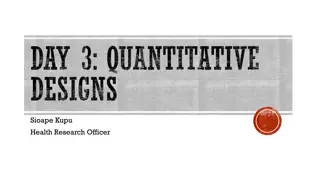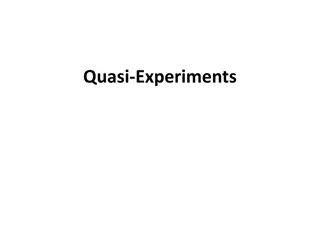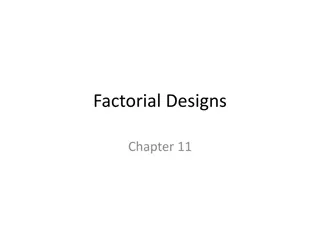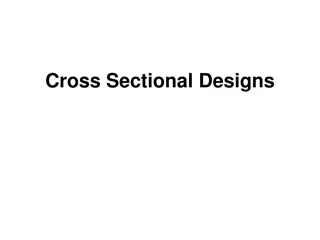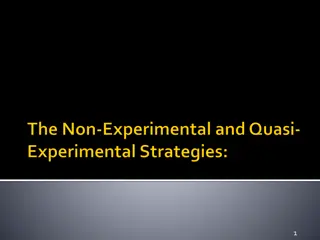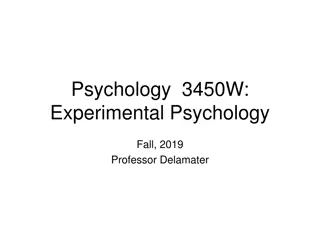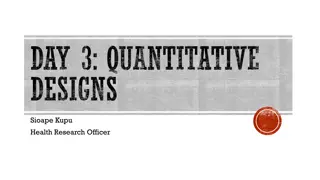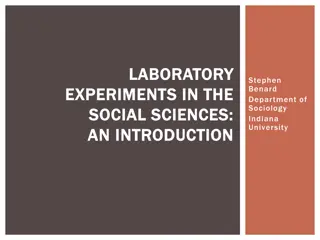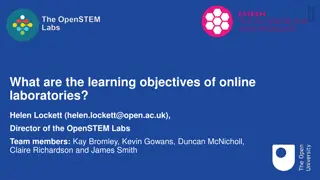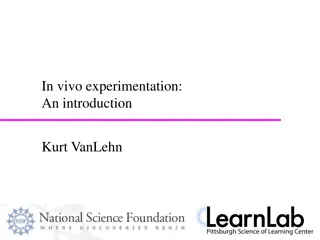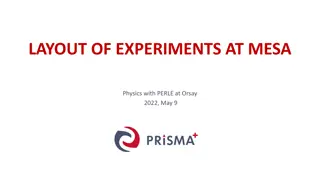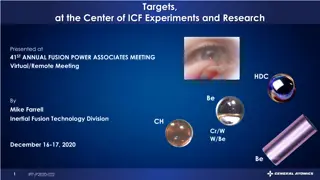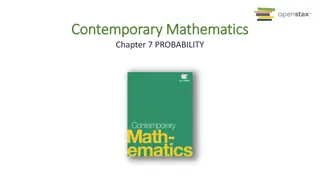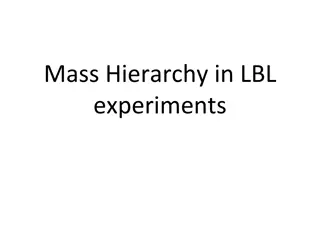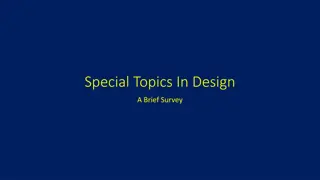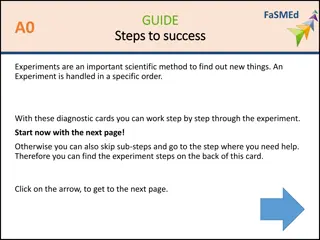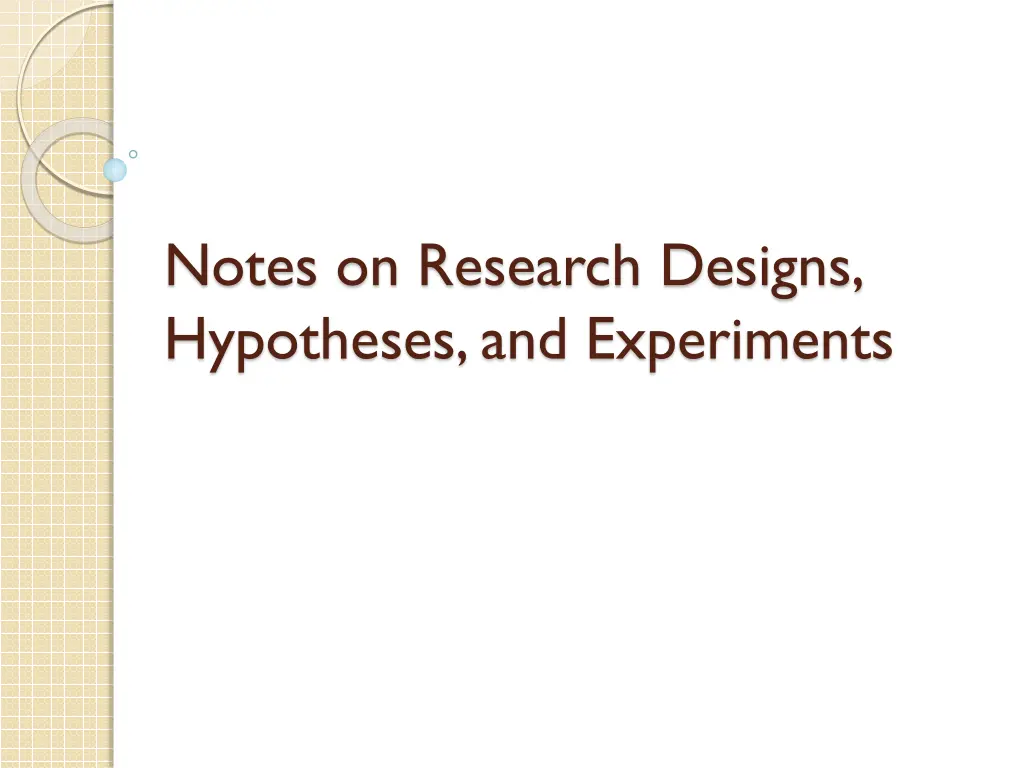
Effective Research Design Strategies and Data Analysis Techniques
Explore the key components of research designs, hypotheses, and experiments. Understand the purpose of research design, data analysis, and weaknesses in research designs. Learn how to create a research proposal, conduct sample selection, data collection, and analyze resulting data. Discover the importance of a well-defined research design in achieving study objectives successfully.
Download Presentation

Please find below an Image/Link to download the presentation.
The content on the website is provided AS IS for your information and personal use only. It may not be sold, licensed, or shared on other websites without obtaining consent from the author. If you encounter any issues during the download, it is possible that the publisher has removed the file from their server.
You are allowed to download the files provided on this website for personal or commercial use, subject to the condition that they are used lawfully. All files are the property of their respective owners.
The content on the website is provided AS IS for your information and personal use only. It may not be sold, licensed, or shared on other websites without obtaining consent from the author.
E N D
Presentation Transcript
Notes on Research Designs, Hypotheses, and Experiments
Recall: Components of the Research Proposal Problem Description/Statement Research Objectives Importance/Benefits of the Study Literature Review Research Design / Data Analysis Deliverables Schedule [Facilities and Special Resources] References Budget (Appendix)
Research Design Is a plan for selecting the sources and types of information used to answer the research question. Is a framework for specifying the relationships among the study s variables Is a blueprint that outlines each procedure from the hypothesis to the analysis of data.
Purpose of the Research Design Describes your project activities in detail Indicates how your objectives will be accomplished and how your hypotheses will be tested Description should include the sequence, flow, and interrelationship of activities, metrics used, evaluation procedures, etc. It should discuss the risks of your method, and indicate why your success is probable Describe the data analysis methods and procedures
Research Design The research design will provide information for tasks such as Sample selection and size Data collection method Benchmarking Instrumentation and metrics Evaluation methods Simulations Ethical requirements Rejected alternative designs
Data Analysis Data Analysis is essentially a four-step process Identify precisely what will be evaluated. If you wrote measurable objectives, you already know. Determine the methods used to evaluate each objective. More precisely, you will need to describe the information/data you will need and how you propose to collect it. Specify the analyses you plan to conduct and the data you need to collect. Your design may be simply to observe behavior of a particular population or something more complex like a rigorous experimental and multiple control group design. Summarize the resulting data analyses and indicate their use. Consider mock data tables that show what your resulting data might look like when the study/experiment is completed. 1. 2. 3. 4.
Weaknesses in Research Designs hypothesis so vague it prevents evaluation inappropriate or impossible data procedures inappropriate for problem Threats to validity (more on this later) Lack of reliable measures lacking controls
Classification of Research Designs Exploratory or formal Observational or communication based Experimental or ex post facto Descriptive or causal Cross-sectional or longitudinal Case or statistical study Field, laboratory or simulation
Exploratory or Formal Exploratory studies tend toward loose structures with the objective of discovering future research tasks Goal - to develop hypotheses or questions for further research Formal study begins where the exploration leaves off and begins with the hypothesis or research question Goal test the hypothesis or answer the research question posed
Observational or Communication Based Observational studies the researcher inspects the activities of a subject or the nature of some material without attempting elicit responses from anyone. Communicational the researcher questions the subjects and collects response by personal or impersonal means.
Experimental or Ex Post Facto In an experiment the researcher attempts to control and/or manipulate the variables in the study. Experimentation provides the most powerful support possible for a hypothesis of causation With an ex post facto design, investigators have no control over the variables in the sense of being able to manipulate them. Report only what has happened or what is happening. Important that researches do not influence variables
Descriptive or Causal If the research is concerned with finding out who, what, where, when or how much then the study is descriptive. If is concerned with finding out why then it is causal. How one variable produces changes in another.
Cross-sectional or Longitudinal Cross-sectional are carried out once and represent a snapshot of one point in time. Longitudinal are repeated over an extended period
Case or Statistical Study Statistical studies are designed for breath rather than depth. They attempt to capture a population s characteristics by making inference from a sample s characteristics. Case studies full contextual analysis of fewer events or conditions and their interrelations. (Remember that a universal can be falsified by a single counter-instance)
Field, Laboratory or Simulation Designs differ in the actual environmental conditions
Quantitative v. Qualitative Approaches Categorize research studies into two broad categories Quantitative relationships among measured variable for the purpose of explaining, predicting and controlling phenomena Qualitative answer question about the complex nature of phenomena with the purpose of describing and understanding from the participant s point of view
More on Hypotheses and Experiments
Hypotheses Tentative proposition formulated for empirical testing Means for guiding and directing kinds of data to be collected what experiments will be conducted analysis and interpretation acceptance or rejection is dependant on data
Examples of Hypotheses Error-based pruning reduces the size of decision trees (as measured in the number of nodes) without decreasing accuracy (as measured by error rate) The use of relevance feedback in an information retrieval system, results in more effective information discovery by users (as measured in terms of time to task completion) The proposed approach for generating item recommendations based on association rule discovery on purchase histories results in more accurate predictions of future purchases when compared to the baseline approach. [From a Google experiment] Longer documents tend to be ranked more accurately than shorter documents because their topics can be estimated with lower variance.
Types of Hypotheses Existential An entity or phenomenon exists (perhaps with a specified frequency) Atoms contain uncharged subatomic particles (neutrons) Compositional An entity or phenomenon consists of a number of related parts or components (perhaps with a specified frequency) Atoms consist of proton, electrons, and neutrons. All decision tree algorithms can be divided into a growing phase and a pruning phase.
Types of Hypotheses Correlational Two measurable quantities have a specified association An element s atomic weight and its properties are correlated. The size of a decision tree constructed using error- based pruning grows linearly with the size of training set. Casual A given behavior has a specified causal mechanism The low reactivity of noble gases is caused by their full outer shell of valence electrons. The use of relevance feedback results in more effective information discovery by users
Rejecting the Hypothesis Often researchers set out to disprove an opposite/competing hypothesis Example: We believe that test strategy A uncovers more faults than test strategy B. So our hypothesis will be that Programmers using test strategy A will uncover more faults than programmers using test strategy B for the same program.
Rejecting the Hypothesis However, we cannot actually prove this hypothesis, we instead will try to disprove an opposite hypothesis There will be no significant difference in the fault detection rate of programmers using test strategy A and those using test strategy B for the same program.
Rejecting the Hypothesis If there is a significant difference in the fault detection rate we can reject the no difference and by default, support our research hypothesis the no difference = null hypothesis
Recall: Falsifiability Falsifiability is the logical possibility that an assertion can be shown to be false by evidence Does not mean false. Instead, if a falsifiable proposition is false, its falsehood can be shown by experimentation, proof, or simulation. There are different degrees of falsifiability What make a hypothesis unfalsifiable? Vagueness theory does not predict any particular experimental outcome Complexity/Generality theory explains any experimental result Special pleading traditional experimental methods are claimed not to apply
Experiments Studies involving the intervention by the researcher beyond that required for measurement usually, manipulate some variable in a setting and observe how it affects the subject (cause and effect) there is at least one independent variable and one dependent variable
Empirical Methods in Artificial Intelligence, 1995, by Paul R. Cohn
Independent Variable Variable the researcher manipulates For our hypothesis concerning test strategies, we may take a sample of software engineers and randomly assign each to one of two groups: one using test strategy A and the other test strategy B. Later we compare the fault detection rate in the two groups. We are manipulating the test strategy, thus it is the independent variable
Dependent Variable Variable that is potentially influenced by the independent variable in our last example, the dependent variable is fault detection rate Presumably the fault detection rate is influenced by test strategy applied there can be more than one dependent variable
Conducting an Experiment Seven activities select relevant variables specify the level(s) of treatment control the experimental environment choose the experimental design select and assign the subjects or data samples pilot-test, revise, and test analyze the data
Select the Relevant Variables Translate our problem into the hypothesis that best states the objectives of the research how concepts are transformed into variables to make them measurable and subject to testing research question: Does a product presentation that describes product benefits in the introduction lead to improved retention of the product knowledge?
The Speculation Product presentations in which the benefits module is placed in the introduction of a 12 minute message produce better retention of product knowledge than those where the benefits module is placed in the conclusion.
Researchers Challenge Select variables that are the best operational representations of the original concepts. Sales presentation, product benefits retention, product knowledge Determine how many variables to test constrained by budget, the time allocated, the availability of appropriate controls, and the number of subjects
Researchers Challenge Select or design appropriate measures/metrics for them thorough review of the available literature and instruments. Adapted to unique needs of the research situation
Choosing an Experimental Design Experimental designs are unique to the experimental method statistical plans to designate relationships between experimental treatments and the experimenter s observations improve the probability that the observed change in the dependent variable was caused by the manipulation of the independent variable
The Validity of Your Method Accuracy, meaningfulness, an credibility Most important questions: Does the study have sufficient controls to ensure that the conclusions we draw are truly warranted by the data? (internal validity) Can we ensure that the instruments, constructs, models used in the study are actually appropriate for explaining the observations (construct validity) Can we use what we have observed in the research situation to make generalizations about the world beyond that specific situation? (external validity)
Strategies to reduce internal validity problems Controlled laboratory study Randomaization A double-blind experiment Unobtrusive measures (to see where people use the library look at worn flooring) Triangulation multiple sources
Strategies to enhance external validity A real-life setting artificial settings may be quite dissimilar from real-life circumstances Representative sample Replication in a different context
Formal Notion of Validity The best available approximation to the truth of a given proposition, inference, or conclusion Source: Research Methods Knowledgebase
Checklist on Validity Conclusion Validity: Is there a relationship between the two variables? Internal Validity: Assuming that there is a relationship, is it a causal one? Construct Validity: Assuming that there is a causal relationship, can we claim that the program reflected our construct of the program and that our measure reflected well our idea of the construct of the measure? External Validity: Can we generalize the (causal) effect to other settings, domains, persons, places or times?
Types of Validity Source: Research Methods Knowledgebase
Validity in Measurements A form of construct validity: the extend to which instrument measures what is supposed to be measured E.g., thermometer temperature E.g., IQ Test Intelligence? E.g., CPU time algorithm complexity or efficiency
Reliability of Measurement Reliability: accuracy and consistency by which the instrument can perform measurement Accuracy exists only if there is consistency (not necessarily the other way around) Need to measure more than once Reliability is a necessary but not sufficient condition for validity

